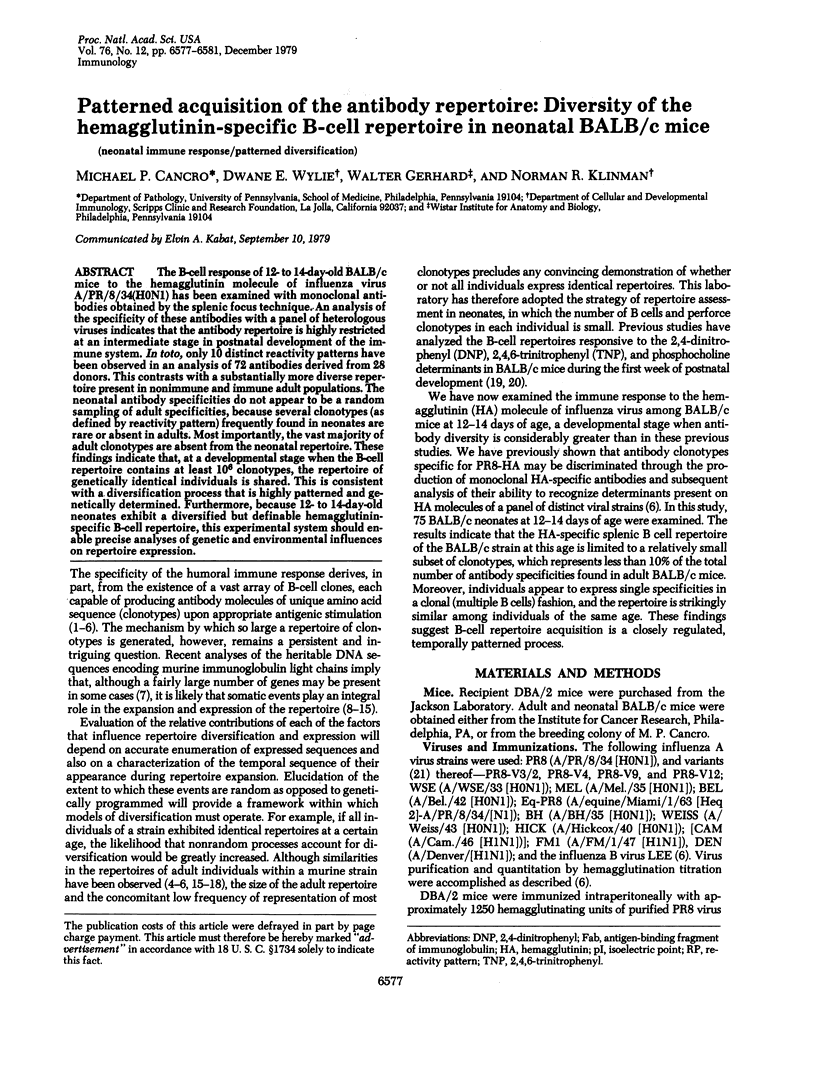Abstract
The B-cell response of 12- to 14-day old BALB/c mice to the hemagglutinin molecule of influenzae virus A/PR/8/34(H0N1) has been examined with monoclonal antibodies obtained by the splenic focus technique. An analysis of the specificity of these antibodies with a panel of heterologous viruses indicates that the antibody repertoire is highly restricted at an intermediate stage in postnatal development of the immune system. In toto, only 10 distinct reactivity patterns have been observed in an analysis of 72 antibodies derived from 28 donors. This contrasts with a substantially more diverse repertoire present in nonimmune and immune adult populations. The neonatal antibody specificities do not appear to be a random sampling of adult specificities, because several clonotypes (as defined by reactivity pattern) frequently found in neonates are rare or absent in adults. Most importantly, the vast majority of adult clonotypes are absent from the neonatal repertoire. These findings indicate that, at a developmental stage when the B-cell repertoire contains at least 10(6) clonotypes, the repertoire of genetically identical individuals is shared. This is consistent with a diversification process that is highly patterned and genetically determined. Furthermore, because 12- to 14-day-old neonates exhibit a diversified but definable hemagglutinin-specific B-cell repertoire, this experimental system should enable precise analyses of genetic and environmental influences on repertoire expression.
Full text
PDF




Selected References
These references are in PubMed. This may not be the complete list of references from this article.
- Cancro M. P., Gerhard W., Klinman N. R. The diversity of the influenza-specific primary B-cell repertoire in BALB/c mice. J Exp Med. 1978 Mar 1;147(3):776–787. doi: 10.1084/jem.147.3.776. [DOI] [PMC free article] [PubMed] [Google Scholar]
- Gally J. A., Edelman G. M. Somatic translocation of antibody genes. Nature. 1970 Jul 25;227(5256):341–348. doi: 10.1038/227341a0. [DOI] [PubMed] [Google Scholar]
- Gerhard W., Webster R. G. Antigenic drift in influenza A viruses. I. Selection and characterization of antigenic variants of A/PR/8/34 (HON1) influenza virus with monoclonal antibodies. J Exp Med. 1978 Aug 1;148(2):383–392. doi: 10.1084/jem.148.2.383. [DOI] [PMC free article] [PubMed] [Google Scholar]
- Hood L., Talmage D. W. Mechanism of antibody diversity: germ line basis for variability. Science. 1970 Apr 17;168(3929):325–334. doi: 10.1126/science.168.3929.325. [DOI] [PubMed] [Google Scholar]
- Jerne N. K. The somatic generation of immune recognition. Eur J Immunol. 1971 Jan;1(1):1–9. doi: 10.1002/eji.1830010102. [DOI] [PubMed] [Google Scholar]
- Kabat E. A., Wu T. T., Bilofsky H. Variable region genes for the immunoglobulin framework are assembled from small segments of DNA--a hypothesis. Proc Natl Acad Sci U S A. 1978 May;75(5):2429–2433. doi: 10.1073/pnas.75.5.2429. [DOI] [PMC free article] [PubMed] [Google Scholar]
- Klinman N. R. Antibody with homogeneous antigen binding produced by splenic foci in organ culture. Immunochemistry. 1969 Sep;6(5):757–759. doi: 10.1016/0019-2791(67)90140-1. [DOI] [PubMed] [Google Scholar]
- Klinman N. R., Pickard A. R., Sigal N. H., Gearhart P. J., Metcalf E. S., Pierce S. K. Assessing B cell diversification by antigen receptor and precursor cell analysis. Ann Immunol (Paris) 1976 Jun-Jul;127(3-4):489–502. [PubMed] [Google Scholar]
- Klinman N. R., Press J. L. The characterization fo the B-cell repertoire specific for the 2,4-dinitrophenyl and 2,4,6-trinitrophenyl determinants in neonatal BALB/c mice. J Exp Med. 1975 May 1;141(5):1133–1146. doi: 10.1084/jem.141.5.1133. [DOI] [PMC free article] [PubMed] [Google Scholar]
- Klinman N. R. The mechanism of antigenic stimulation of primary and secondary clonal precursor cells. J Exp Med. 1972 Aug 1;136(2):241–260. doi: 10.1084/jem.136.2.241. [DOI] [PMC free article] [PubMed] [Google Scholar]
- Köhler G., Melchers F. Isoelectric focusing spectra of antibodies which activate mutant -galactosidases. Eur J Immunol. 1972 Oct;2(5):453–456. doi: 10.1002/eji.1830020514. [DOI] [PubMed] [Google Scholar]
- McKean D. J., Bell M., Potter M. Mechanisms of antibody diversity: multiple genes encode structurally related mouse kappa variable regions. Proc Natl Acad Sci U S A. 1978 Aug;75(8):3913–3917. doi: 10.1073/pnas.75.8.3913. [DOI] [PMC free article] [PubMed] [Google Scholar]
- Mäkelä O., Imanishi T. Expression of an immunoglobulin VH gene in natural anti-hapten antibodies. Eur J Immunol. 1975 Mar;5(3):202–205. doi: 10.1002/eji.1830050310. [DOI] [PubMed] [Google Scholar]
- Nisonoff A., Ju S. Studies of a cross-reactive idiotype associated with anti-para-azophenylarsonate antibodies of A/J mice. Ann Immunol (Paris) 1976 Jun-Jul;127(3-4):347–356. [PubMed] [Google Scholar]
- Pierce S. K., Klinman N. R. Antibody-specific immunoregulation. J Exp Med. 1977 Aug 1;146(2):509–519. doi: 10.1084/jem.146.2.509. [DOI] [PMC free article] [PubMed] [Google Scholar]
- Pink J. R., Askonas B. A. Diversity of antibodies to cross-reacting nitrophenyl haptens in inbred mice. Eur J Immunol. 1974 Jun;4(6):426–430. doi: 10.1002/eji.1830040608. [DOI] [PubMed] [Google Scholar]
- Press J. L., Klinman N. R. Isoelectric analysis of neonatal monofocal antibody. Immunochemistry. 1973 Sep;10(9):621–627. doi: 10.1016/0019-2791(73)90164-x. [DOI] [PubMed] [Google Scholar]
- Seidman J. G., Leder A., Edgell M. H., Polsky F., Tilghman S. M., Tiemeier D. C., Leder P. Multiple related immunoglobulin variable-region genes identified by cloning and sequence analysis. Proc Natl Acad Sci U S A. 1978 Aug;75(8):3881–3885. doi: 10.1073/pnas.75.8.3881. [DOI] [PMC free article] [PubMed] [Google Scholar]
- Sigal N. H., Gearhart P. J., Press J. L., Klinman N. R. Late acquisition of a germ line antibody specificity. Nature. 1976 Jan 1;259(5538):51–52. doi: 10.1038/259051a0. [DOI] [PubMed] [Google Scholar]
- Tonegawa S. Reiteration frequency of immunoglobulin light chain genes: further evidence for somatic generation of antibody diversity. Proc Natl Acad Sci U S A. 1976 Jan;73(1):203–207. doi: 10.1073/pnas.73.1.203. [DOI] [PMC free article] [PubMed] [Google Scholar]


